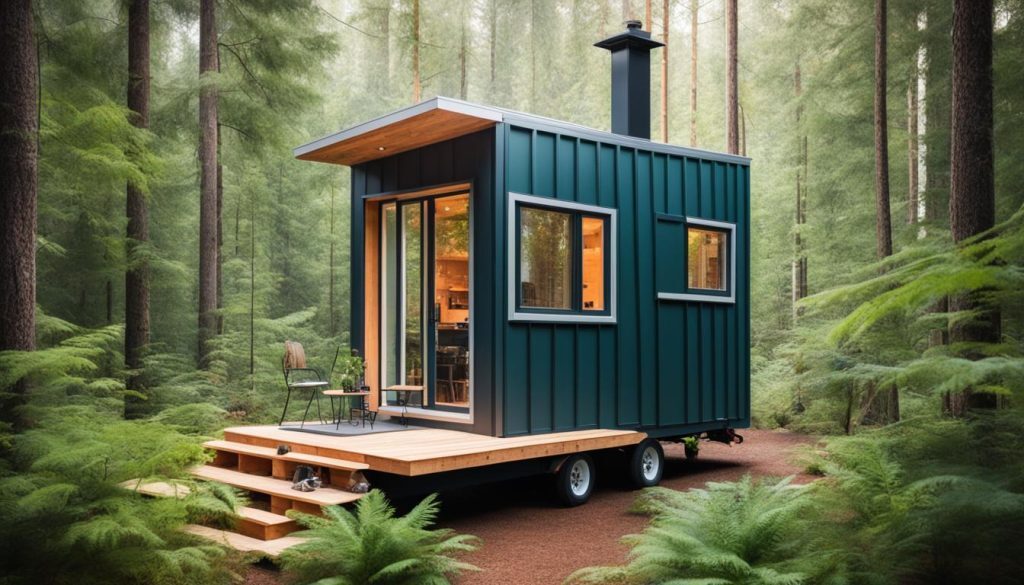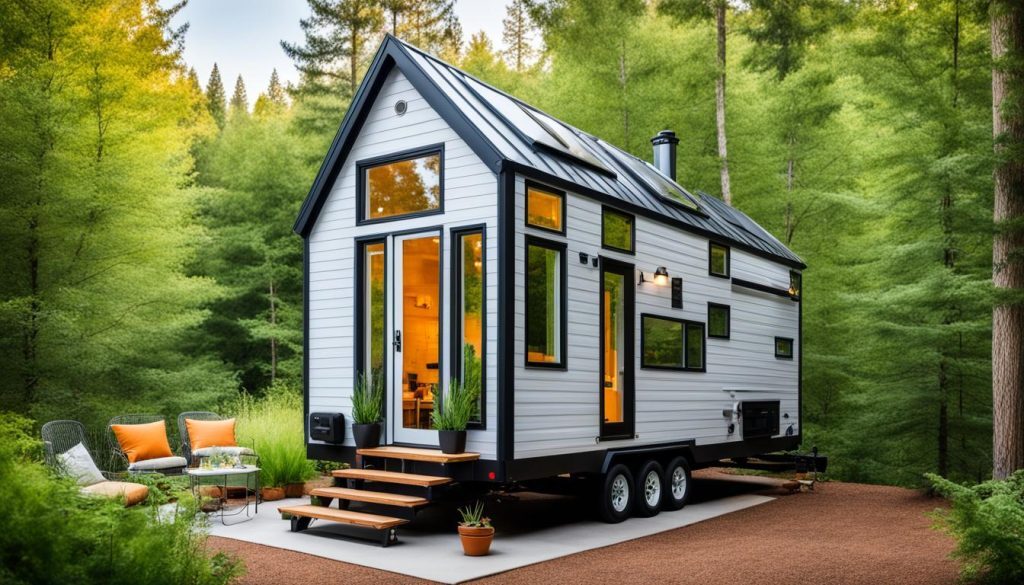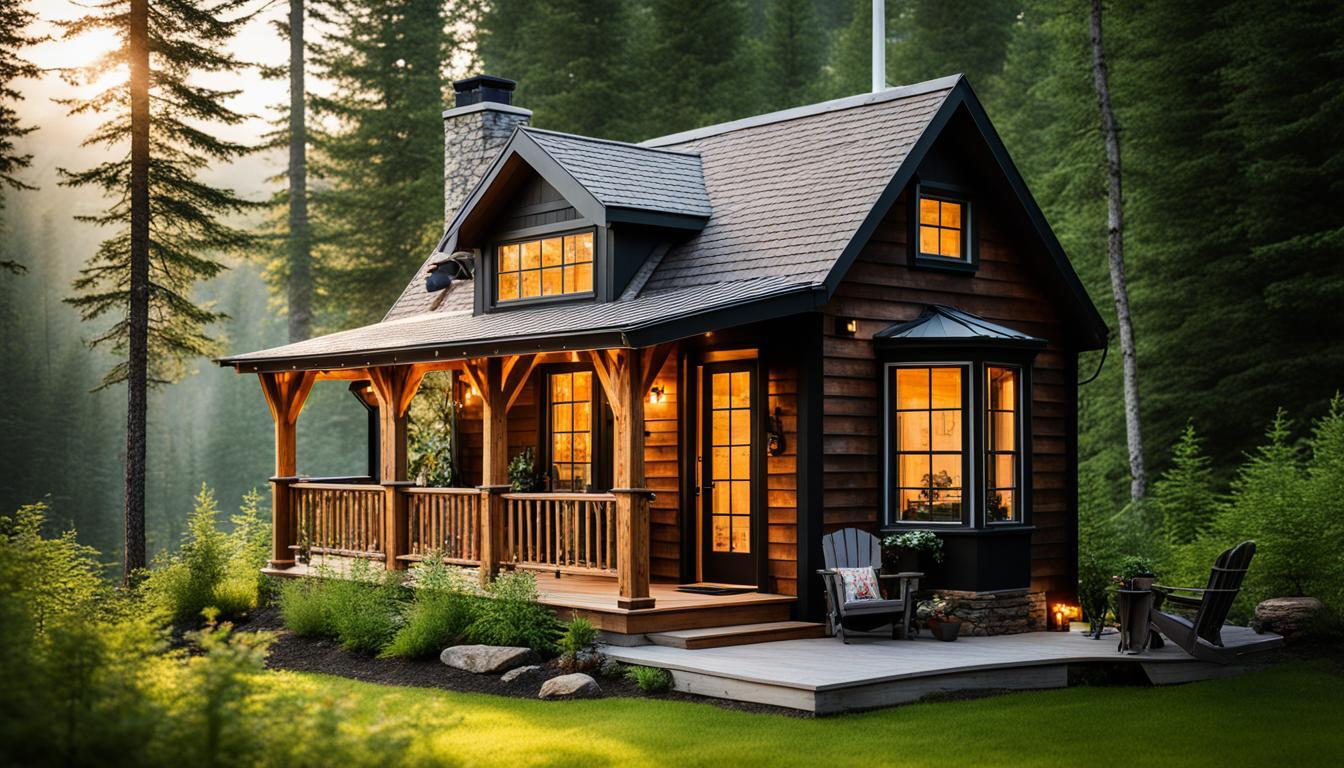Did you know that Canada is facing an affordable housing crisis, leaving 235,000 Canadians experiencing homelessness?
The responsibility for affordable housing and homelessness programs in Canada has shifted from the federal government to provinces and now to municipalities. With this crisis at hand, it’s crucial to explore alternative housing solutions that are not only cost-effective but also provide a sense of stability and community.
In this article, I will delve into the world of tiny homes in Canada, offering my insights and tips on how they can be a viable solution to the affordable housing crisis. From the cost of tiny homes to their benefits and financing options, I’ll guide you through everything you need to know about embracing the tiny living movement.
Key Takeaways:
- Tiny homes provide a cost-effective and quickly deployable solution for affordable housing in Canada.
- Living in a tiny home offers a transformative experience, embracing a simpler and intentional way of life.
- Factors such as local regulations, zoning restrictions, and long-term costs should be considered when choosing a tiny home.
- Financing options and the construction process ensure that tiny homes are accessible and built to high-quality standards.
- Tiny homes come with various features and options, allowing for customization and personalization.
Benefits of Living in a Tiny Home
Living in a tiny home offers a transformative experience, embracing a simpler and intentional way of life. With limited space, you’re encouraged to practice mindful consumption and get creative with storage solutions. It’s an opportunity to declutter your life and prioritize experiences over material possessions.
Tiny homes also foster a closer connection with nature. Whether you’re parked in the peaceful countryside or nestled in an urban backyard, living tiny allows you to appreciate the beauty of your surroundings and enjoy a simpler, more sustainable lifestyle.
Speaking of sustainability, tiny homes have a reduced environmental impact compared to traditional houses. They consume fewer resources and require less energy for heating and cooling. By choosing to live in a tiny home, you’re contributing to a greener future.
Living tiny brings a sense of freedom and minimalism. With fewer possessions and a smaller living space, you’re liberated from the burden of excess. Instead, you can focus on what truly matters to you, whether it’s pursuing a passion, traveling, or spending quality time with loved ones.
One of the significant advantages of tiny homes is their affordability. Building a tiny home typically involves lower costs compared to traditional housing. From construction materials to labor expenses, the overall expenses are significantly reduced. Additionally, maintenance costs for a tiny home are generally lower, allowing you to save money in the long run.
The cost of living in a tiny home is also substantially lower than that of a traditional house. With reduced utility bills and a smaller mortgage or rental payment, tiny home dwellers can enjoy financial freedom, pay off debt, or save for other goals.
To sum it up, living in a tiny home not only provides a unique and fulfilling lifestyle but also offers a cost-effective alternative to traditional housing. It allows you to live with intention, connect with nature, minimize your ecological footprint, and achieve greater financial independence.
Factors to Consider When Choosing a Tiny Home
When it comes to choosing a tiny home, there are several factors to consider to ensure that it meets your needs and preferences while remaining within your budget. Here are some crucial considerations:
- Local Regulations and Zoning Restrictions: Before purchasing or building a tiny home, it’s essential to research and understand the local regulations and zoning restrictions in your area. Depending on where you live, tiny homes may be allowed on farms, rural properties, or as secondary dwellings beside existing homes in the city. Knowing the rules and limitations will help you determine the feasibility and options available to you.
- Permits and Building Codes: Obtaining the necessary permits and ensuring compliance with building codes is a vital step in the process of owning a tiny home. Different jurisdictions may have specific requirements for tiny homes, including size limitations, safety standards, and utility connections. It’s crucial to understand and follow these regulations to avoid potential legal issues.
- Tiny Home Cost: The cost of a tiny home can vary depending on various factors, such as size, materials used, and customization options. Comparing the cost of different tiny home models and builders will help you find the most affordable and cost-effective option. Consider your budget and prioritize features based on your needs and preferences.
- Long-Term Costs: In addition to the upfront cost, it’s important to consider the long-term expenses associated with owning a tiny home. This includes utilities, maintenance costs, and potential resale value. While tiny homes are generally more cost-effective than traditional houses, understanding the ongoing expenses will help you budget effectively and make an informed decision.
By considering these factors, you can make an informed choice when selecting a tiny home that aligns with your lifestyle, budget, and local regulations.
Financing and Construction of Tiny Homes
When it comes to financing your tiny home dream, affordable options are available to make it a reality. With monthly payments as low as $800 a month, you can find a financing plan that suits your budget and allows you to embrace the cost-effective and sustainable lifestyle.
Assistance is also provided in obtaining loans for tiny homes, ensuring that financial constraints do not hinder your journey towards living in a beautiful and affordable small house. The goal is to make the process as smooth as possible, allowing you to focus on the excitement of building your dream tiny home.
Construction of tiny homes is carried out by teams of skilled and licensed professionals who are experts in their fields. Carpenters, electricians, plumbers, and designers work together to create a space that is not only functional and durable but also meets all building code requirements. The meticulous construction process ensures that your tiny home is of the highest quality.
One significant advantage of tiny homes is their superior insulation, such as spray foam insulation, which provides exceptional thermal efficiency. This ensures that your tiny home is comfortable throughout the year, regardless of the weather outside. You can enjoy living in a cozy space while saving on heating and cooling costs.
In addition to insulation, tiny homes can also integrate solar systems, enabling off-grid living and reducing reliance on traditional utility systems. By harnessing the power of the sun, you not only decrease your carbon footprint but also significantly lower your monthly utility bills. It’s a sustainable and cost-effective solution that aligns perfectly with the tiny home lifestyle.

Whether you choose to finance or build your tiny home, you can rest assured that it’s a well-designed and expertly constructed space. The financing options and construction process prioritize affordability, quality, and sustainability, ensuring that your tiny home journey is everything you dreamed it would be.
Tiny Home Features and Options
When it comes to tiny homes, there is no shortage of features and options that can be customized to meet individual preferences and needs. Whether you’re looking for a sleek, modern design or a cozy, rustic aesthetic, there’s a tiny home style for everyone.
One of the main advantages of tiny homes is the ability to tailor the layout and design to suit your lifestyle. From open-concept spaces to multi-level floor plans, the possibilities are endless. You can choose the number and size of rooms, the placement of windows and doors, and even incorporate unique architectural elements to make your tiny home truly one-of-a-kind.
In terms of finishes, you can select from a wide range of materials, colors, and textures to create the perfect ambiance. Whether you prefer hardwood floors, stainless steel appliances, or reclaimed wood accents, there are countless options to customize the interior of your tiny home to reflect your personal style and taste.
For those looking to reduce their carbon footprint and live sustainably, premium features like rooftop solar panels, spray foam insulation, and efficient heating and cooling systems are available. These features not only contribute to the overall quality and sustainability of the tiny home but can also help reduce energy costs in the long run.
When it comes to functionality, tiny homes offer versatile electrical solutions and streamlined sewage management systems. Creative storage solutions, innovative space-saving furniture, and built-in organization systems ensure that every inch of your tiny home is utilized efficiently.
In addition to customization options and functional features, comprehensive warranty packages are provided by reputable tiny home builders. These warranties cover different components of the tiny home and provide customers with peace of mind and satisfaction.
To help prospective buyers visualize their future space, virtual 360 tours are available for many tiny home models. These tours allow you to explore and experience the interior of the tiny home from the comfort of your own computer or mobile device, aiding in the decision-making process.

| Feature | Description |
|---|---|
| Rooftop Solar Panels | Generate clean and renewable energy for your tiny home. |
| Spray Foam Insulation | Maximize thermal efficiency and create a comfortable living space. |
| Efficient Heating and Cooling Systems | Keep your tiny home comfortable year-round while minimizing energy consumption. |
| Versatile Electrical Solutions | Customize your electrical setup to meet your power needs. |
| Streamlined Sewage Management Systems | An efficient and user-friendly system for managing waste and wastewater. |
| Comprehensive Warranty Packages | Protect your investment with warranties that cover different components of your tiny home. |
Advantages of Tiny Homes in Rural and Urban Areas
Tiny homes offer versatile housing solutions that can be placed in both rural and urban areas, catering to the diverse needs of different demographics. Whether you are looking to embrace a simpler lifestyle in a rural setting or maximize land use in an urban environment, tiny homes provide unique advantages.
In rural areas, tiny homes are an excellent option for individuals and families seeking affordable housing. They make efficient use of available land and resources, providing a comfortable living space at a fraction of the cost of traditional homes. With their smaller footprint, tiny homes blend harmoniously with the surrounding nature, offering a cozy and sustainable living experience.
In urban areas, tiny homes can be built as laneway suites or placed in existing backyards, presenting innovative housing solutions that make the most of limited space. By utilizing underutilized areas, tiny homes contribute to the reduction of urban sprawl and promote sustainable development. These compact living spaces provide an opportunity for young professionals, empty nesters, and those looking to downsize to enjoy affordable small house prices and experience the benefits of urban living.
The allure of tiny homes lies not only in their affordability but also in their potential to foster a more sustainable and intentional way of life. Living in a tiny home allows individuals to embrace minimalism, reduce environmental impact, and prioritize experiences over possessions.
By integrating tiny homes into both rural and urban landscapes, we can create a more inclusive and diverse housing market that offers affordable options for all. Whether you choose to settle in a serene and expansive rural area or embrace the vibrant energy of an urban setting, tiny homes provide an accessible and cost-effective housing solution.
Tiny Home Listings and Opportunities in Canada
Are you intrigued by the idea of affordable small house prices and budget-friendly tiny living? In Canada, there are numerous listings and opportunities for purchasing or renting tiny homes, allowing you to embrace a more sustainable and cost-effective lifestyle.
Websites and platforms specialized in tiny home real estate offer a wide range of options and information for interested buyers. You can explore various listings and find the perfect tiny home that suits your needs and budget.
Additionally, attending tiny home shows and events can provide valuable insights into tiny home living. These events offer opportunities to learn more about zoning regulations, building codes, and available township allowances, ensuring you have the necessary knowledge to make informed decisions.
Prominent tiny home builders and organizations are also available to provide consultations and guidance to those considering joining the tiny home movement. Whether it’s answering your questions or offering valuable insights, these experts can help you navigate the process and find the ideal tiny home for your lifestyle.
If you prefer the convenience of virtual consultations, you’ll be pleased to know that they are readily available. You can access information, ask questions, and receive guidance from the comfort of your own home, making it easier than ever to explore the world of tiny home living.

Leave a Reply Cancel reply
You must be logged in to post a comment.